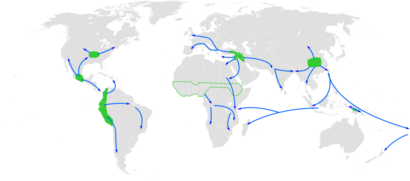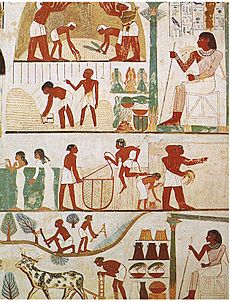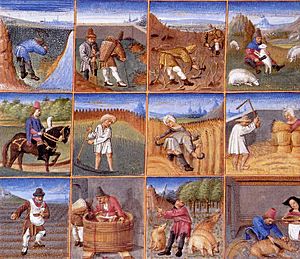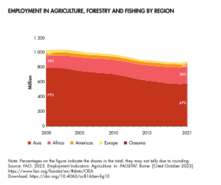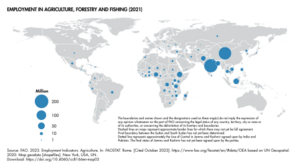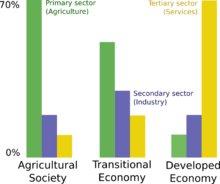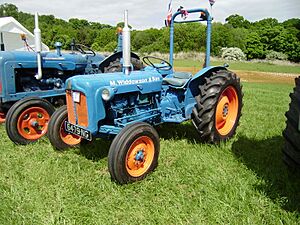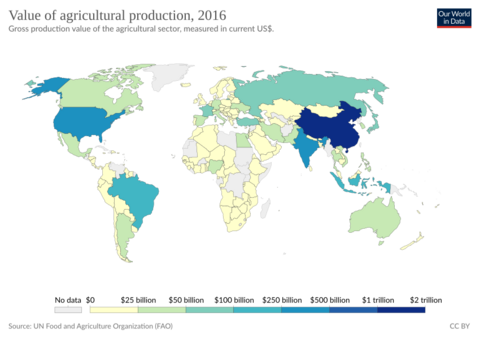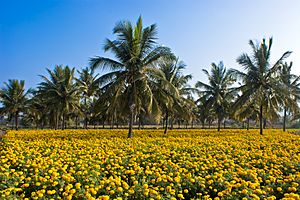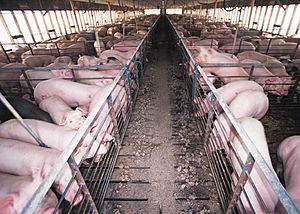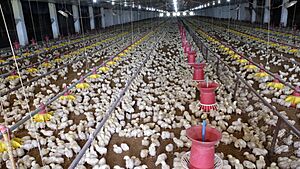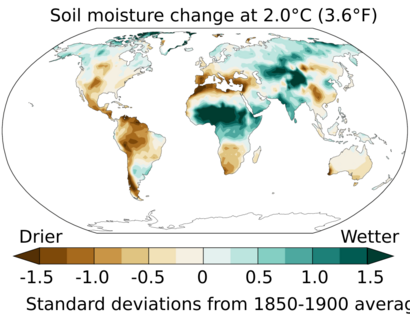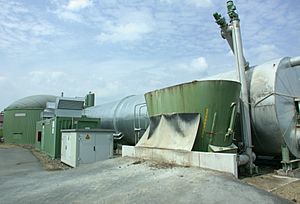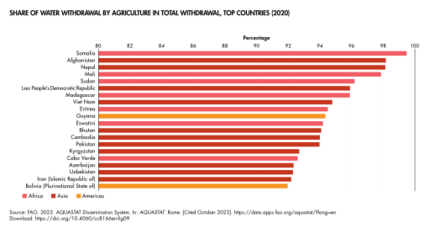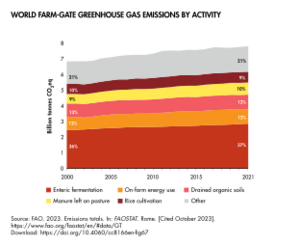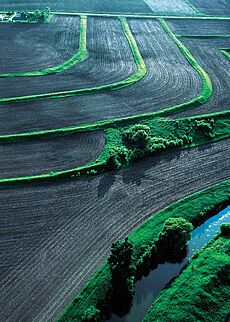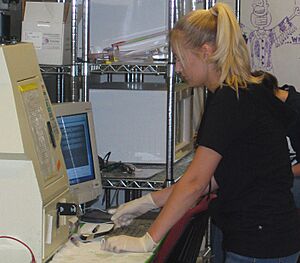Agriculture facts for kids
Agriculture is all about growing crops and raising animals like livestock (cattle, sheep, pigs), fishing, and managing forests. It's how we get food, clothes, fuel, and other useful things. Agriculture was a huge step for human civilization. When people learned to farm, they could produce extra food. This meant they didn't have to move around constantly to find food, and they could start living in permanent places like cities.
Humans started gathering wild grains over 105,000 years ago. But they only began planting them about 11,500 years ago. Animals like sheep, goats, pigs, and cattle were tamed and raised for food and other uses around 10,000 years ago. Plants were first grown independently in at least 11 different parts of the world. In the 1900s, large-scale farming, often growing just one type of crop (called monoculture), became very common.
As of 2021, smaller farms produce about one-third of the world's food, but very large farms are also common. The biggest 1% of farms are larger than 50 hectares (about 124 acres) and cover over 70% of the world's farmland. However, five out of every six farms in the world are smaller than 2 hectares (about 5 acres) and use only about 12% of all agricultural land. Farms and farming are very important for the economy and way of life in rural areas. They affect both the people who work directly on farms and the many businesses that support farming.
The main things we get from agriculture can be put into groups: food (like grains, vegetables, fruits, meat, milk, eggs), fibers (like cotton), fuels, and raw materials (like rubber). Globally, we produce about 11 billion tonnes of food each year. Sadly, about 14% of the world's food is lost before it even reaches stores.
Modern farming methods, new plant types, and chemicals like pesticides and fertilizers have greatly increased how much food we can grow. But these methods have also caused harm to the environment. Raising animals has also become more productive, but it brings up concerns about animal welfare and environmental damage. Farming can contribute to climate change through greenhouse gases, use up underground water, lead to deforestation, and cause pollution. Agriculture is also affected by environmental problems like biodiversity loss, desertification, and soil degradation, which can reduce how much food we grow. Genetically modified organisms (GMOs) are widely used in farming, though some countries have rules against them.
Contents
What Agriculture Means

The word agriculture comes from two Latin words: ager meaning 'field' and cultūra meaning 'cultivation' or 'growing'. So, it literally means 'field cultivation'. While we usually talk about human farming, some ants, termites, and beetles have been "farming" their own crops for millions of years! Agriculture generally means using natural resources to produce things that keep us alive, like food, fibers, and wood. This includes growing crops, raising animals, and forestry.
History of Farming
How Farming Began
Farming allowed the human population to grow much larger than it could when people only hunted and gathered food. Agriculture started independently in many different parts of the world. Wild grains were gathered and eaten at least 105,000 years ago. The first known farming of rice in China happened around 5,700 BC. Sheep were first raised in Mesopotamia (modern-day Iraq) between 13,000 and 11,000 years ago. Cattle were tamed from wild oxen about 10,500 years ago in areas like modern Turkey and Pakistan. Pigs were first raised in Eurasia around the same time.
In South America, potatoes were first grown between 10,000 and 7,000 years ago, along with beans, llamas, and alpacas. Sugarcane started in New Guinea about 9,000 years ago. Sorghum, a grain, was first grown in Africa around 7,000 years ago. Cotton was grown in Peru by 5,600 years ago. In Central America, wild teosinte was bred into maize (corn) between 10,000 and 6,000 years ago. Horses were tamed in the Eurasian grasslands around 3500 BC.
Scientists believe that people first started living in one place more often, and then began planting the wild foods they had been gathering. Over time, these wild plants were changed through careful selection to become the domesticated crops we know today.
Farming in Early Civilizations
In Eurasia, the Sumerians began living in villages around 8,000 BC. They used the Tigris and Euphrates rivers and canals to water their fields. They grew wheat, barley, and vegetables like lentils and onions. The ancient Egyptians relied on the Nile River's yearly floods for farming. They grew grains like wheat and barley, and plants like flax and papyrus. In India, wheat, barley, and jujube (a fruit) were grown by 9,000 BC, and soon after, sheep and goats were raised.
In China, by the 5th century BC, there was a system of grain storage across the country, and silk farming was widespread. Water-powered mills for grinding grain were used by the 1st century BC. By the late 2nd century, heavy plows with iron blades were developed. These plows then spread across Eurasia. In ancient Greece and Rome, the main grains were wheat and barley, along with vegetables like peas and beans. Sheep and goats were kept mostly for milk.
In the Americas, crops like squash, beans, and cacao (for chocolate) were first grown in Central America. Turkeys were probably tamed in Mexico or the American Southwest. The Aztecs built irrigation systems, terraced hillsides, and even artificial islands called chinampas for farming. The Mayas used canals and raised fields to farm swampy land. In South America, farming might have started around 9000 BC with squash and other plants. Coca, peanuts, tomatoes, and pineapples were also grown in the Andes mountains. Llamas, alpacas, and guinea pigs were tamed there.
In North America, native peoples grew crops like sunflowers, tobacco, and squash. They also gathered wild foods like wild rice and maple sugar. A special way of planting called the "Three Sisters" was developed, where winter squash, corn, and climbing beans were grown together.
Some Indigenous Australians, who were thought to be only hunter-gatherers, actually used controlled burning to help plants grow better. The Gunditjmara people developed systems for farming eels and trapping fish about 5,000 years ago.
The Agricultural Revolution
In the Middle Ages, farming in Western Europe focused more on growing enough food for themselves. After 1492, the Columbian exchange brought new crops from the Americas to Europe, like corn, potatoes, and tomatoes. In return, Old World crops like wheat and rice, and animals like horses and cattle, came to the Americas.
From the 1600s, new farming methods like irrigation, crop rotation (changing what you grow in a field each year), and fertilizers helped the global population grow a lot. Since 1900, farming in developed countries has become much more productive. Machines replaced human labor, and synthetic fertilizers and pesticides were widely used. A method called Haber-Bosch allowed the creation of ammonium nitrate fertilizer on a huge scale, which greatly increased crop yields.
Modern agriculture has also led to environmental and economic issues, such as water pollution and concerns about genetically modified organisms. This has led to new ways of farming, like the organic movement.
Types of Farming
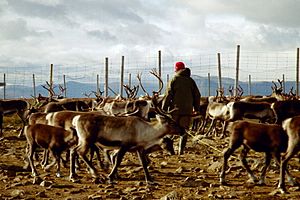
Pastoralism is about raising domesticated animals. In nomadic pastoralism, animals are moved from place to place to find food and water. This is common in dry areas like the Sahara desert and parts of Central Asia.

In shifting cultivation, a small area of forest is cleared by cutting and burning trees. The land is used for a few years until the soil loses its nutrients, then it's left to regrow, and farmers move to a new spot. This is done in places with lots of rain, like Northeast India and the Amazon.
Subsistence farming means growing just enough food to feed your family or local community, with little left over to sell. About 2.5 billion subsistence farmers worked in 2018, using about 60% of the world's farmland.
Intensive farming aims to grow as much as possible from the land. It uses a lot of water, fertilizer, pesticides, and machines. This type of farming is common in developed countries.
Modern Agriculture
Current Situation
Since the 1900s, intensive agriculture has greatly increased how much food we can grow. But it has also led to more water pollution and often relies on government support. Soil degradation (when soil becomes less healthy) is a big problem; about 40% of the world's farmland is seriously damaged. Recently, there's been a push for more environmentally friendly farming, leading to movements like organic farming and sustainable agriculture. These methods try to grow food in a way that protects the environment for the future.
By 2015, China produced the most agricultural goods in the world, followed by the European Union, India, and the United States. In 2021, agriculture employed 873 million people, which is about 27% of all workers worldwide.
Even with more food being produced, between 702 and 828 million people were affected by hunger in 2021. Hunger and poor nutrition can be caused by conflicts, extreme weather, and economic problems.
People Working in Agriculture
Agriculture provides about a quarter of all jobs globally. In many developing countries, it's more than half. As countries become more developed, people tend to move away from farming jobs to other types of work. Machines also help farmers do more work with fewer people.
In the 16th century in Europe, about 55-75% of people worked in farming. Today, in those same countries, it's less than 10%. At the start of the 21st century, about one billion people worked in agriculture. This includes about 70% of child workers globally and a large percentage of women in many countries.
In many developed countries, immigrants often help fill jobs in farming that are hard to do with machines. For example, in the United States, more than half of all hired farmworkers in 2019 were immigrants.
Women in Agriculture
Women make up a large part of the farming workforce around the world. This share is growing in most developing regions. The Food and Agriculture Organization of the United Nations (FAO) says that women's roles in farming might be changing, for example, from growing food for their families to working for wages.
Generally, women are more involved in farming in countries with lower economic development. This is because they might have less education, limited access to markets, and many unpaid chores, which limit their chances for other jobs. Women in farming often work in difficult conditions and are less likely to own land or be independent farmers. They also tend to grow less profitable crops.
Women farmers often have less access than men to important things like good seeds, fertilizers, and machines. However, there's good news: the gap in access to mobile internet and bank accounts for women in low- and middle-income countries has been shrinking. When women have equal access to resources, they are just as likely as men to use new technologies.
Safety in Farming
Farming can be a dangerous job. Farmers around the world face risks of injuries, lung diseases, hearing loss, skin problems, and certain cancers from chemicals and sun exposure. On large, industrial farms, injuries often involve using big machines. A common cause of deadly injuries is tractors overturning. Pesticides and other chemicals can also be harmful to workers. Since farming often involves families living and working on the farm, everyone, including children, can be at risk.
The International Labour Organization says agriculture is "one of the most hazardous of all economic sectors." They estimate that at least 170,000 agricultural workers die each year from work-related causes, which is twice the average rate of other jobs. Many injuries and illnesses also go unreported.
What We Produce
The total amount of food and other products produced varies by country. China has the largest agricultural output, followed by the European Union, India, and the United States.
How Crops are Grown

The ways crops are grown depend on things like available resources, climate, government rules, and the farmer's beliefs.
Shifting cultivation (also called slash and burn) is when forests are burned to release nutrients into the soil. Crops are grown for a few years, then the land is left to regrow forest, and the farmer moves to a new area. This helps the soil recover.
Monoculture is when only one type of crop is planted over a large area. This can lead to more pest problems and a greater need for pesticides and fertilizers. Multiple cropping is when several crops are grown one after another in the same year. Intercropping is when different crops are grown at the same time in the same field. These are types of polyculture, which means growing many different things.
In dry areas, farming might be limited by rainfall, so farmers often use irrigation to water their crops.
Important types of food crops include cereals (like wheat and rice), legumes (like beans), fruits, and vegetables. Natural fibers include cotton and flax.
| Top Agricultural Products, by Crop Types (million tonnes) 2004 data |
|
|---|---|
| Cereals | 2,263 |
| Vegetables and melons | 866 |
| Roots and tubers | 715 |
| Milk | 619 |
| Fruit | 503 |
| Meat | 259 |
| Oilcrops | 133 |
| Fish (2001 estimate) | 130 |
| Eggs | 63 |
| Pulses | 60 |
| Vegetable fiber | 30 |
| Source: Food and Agriculture Organization | |
| Top Agricultural Products, by Individual Crops (million tonnes) 2011 data |
|
|---|---|
| Sugar cane | 1794 |
| Maize | 883 |
| Rice | 722 |
| Wheat | 704 |
| Potatoes | 374 |
| Sugar beet | 271 |
| Soybeans | 260 |
| Cassava | 252 |
| Tomatoes | 159 |
| Barley | 134 |
| Source: Food and Agriculture Organization | |
How Animals are Raised
Animal husbandry is about breeding and raising animals for meat, milk, eggs, wool, or for work and transport. Animals like horses, oxen, and camels have been used for centuries to help with farm work and transport goods.
About 70% of all land used for agriculture is for raising livestock. It's also a big source of greenhouse gases. The number of cattle, sheep, and goats is expected to keep growing a lot until 2050. Aquaculture, or fish farming, is one of the fastest-growing ways to produce food.
In the past, farmers focused on breeding animals that produced more, but this sometimes meant losing genetic diversity. This can make animals less resistant to diseases.
Some livestock systems rely on animals eating grass in pastures. Other systems mix grass, special feed crops, and grains. Manure from animals is often used as fertilizer for crops. Landless systems rely on buying feed from outside the farm. These are common in developed countries and are used to produce much of the world's poultry (chicken) and pork. Many animals are raised in confined animal feeding operations, sometimes called factory farming.
Farming Practices

Tillage is when farmers break up the soil with tools like plows to prepare for planting, add nutrients, or control pests. Tillage can help crops grow by warming the soil and mixing in fertilizer, but it can also make the soil more likely to erode (wash away) and harm soil organisms.
Pest control means managing weeds, insects, and diseases. Farmers use chemicals (pesticides), natural methods (like using good insects to eat bad ones), machines, and cultural practices (like crop rotation). Integrated pest management tries to use all these methods to keep pests under control without relying too much on pesticides.
Nutrient management is about making sure crops and animals get enough nutrients. This can involve using chemical fertilizers, animal manure, or compost.
Water management is important where there isn't enough rain. Farmers might use irrigation to water their crops. Agriculture uses about 70% of the world's freshwater. In some countries, it's as high as 90%. New technologies in precision agriculture help farmers use water more efficiently.
Agricultural automation means using machines and equipment to help with farming tasks. This can range from tractors to robots and digital tools like sensors. These technologies can help farmers diagnose problems, make decisions, and perform tasks more easily and precisely. Automation can reduce the need for human labor for certain tasks, but it also creates new jobs for maintaining and operating the equipment.
How Climate Change Affects Farming
Climate change and agriculture are closely linked. Climate change affects farming through changes in average temperatures, rainfall, and extreme weather events like storms and heat waves. It also changes where pests and diseases can spread. Global warming is already impacting agriculture, but the effects are different in various parts of the world.
A 2022 report said that human-caused warming has slowed down the growth of farming productivity over the last 50 years in many regions. Warming also negatively affects the quality of crops and grasslands. Climate change will likely increase the risk of food insecurity for vulnerable groups, like the poor.
Improving Crops and Using Biotechnology
Plant Breeding
Humans have been changing crops through breeding for thousands of years. By choosing plants with good traits (like larger fruits or resistance to drought), farmers have improved crops. Important discoveries by a scientist named Gregor Mendel helped breeders understand how traits are passed down.
Over centuries, plant breeding has led to higher yields, better disease resistance, and improved taste and nutrition in crops. The Green Revolution in the 1900s used traditional breeding to create "high-yielding varieties" that greatly increased food production. For example, corn yields in the US grew from about 2.5 tons per hectare in 1900 to about 9.4 tons per hectare in 2001.
Genetic Engineering

Genetically modified organisms (GMOs) are living things whose genetic material has been changed using special techniques. Genetic engineering allows breeders to add genes from different sources to create new crops with desired traits. These traits can include increased durability, better nutrition, resistance to insects and viruses, or tolerance to herbicides.
Some people have concerns about the safety of GMO foods and how they are labeled. Many countries have rules about growing, importing, or using GMO foods. There's an ongoing discussion about whether foods made from GMOs should always be labeled.
Herbicide-resistant seeds have a gene that allows the plants to survive when sprayed with herbicides. This lets farmers spray to control weeds without harming their crops. However, some weeds have developed resistance to these herbicides, leading farmers to use other chemicals.
Other GMO crops are insect-resistant. They have a gene from a special bacterium that produces a toxin harmful to insects. These crops can resist insect damage.
Environmental Impact
Effects and Costs
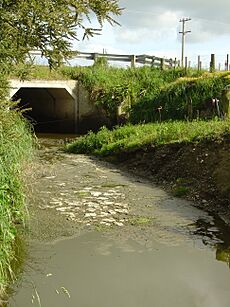
Agriculture both causes and is affected by environmental damage. It's a major reason for things like biodiversity loss, desertification, soil degradation, and climate change. Farming is also a main source of toxins released into the environment, especially insecticides used on crops like cotton. In 2011, a report said that farming activities produced about 13% of global greenhouse gas emissions.
Farming tries to increase how much food it produces and lower costs. This often means reducing biodiversity. For example, making fields larger means removing hedges and ditches, which are habitats for many animals. Pesticides kill insects, plants, and fungi.
Livestock Issues
A UN official once said that "Livestock are one of the most significant contributors to today's most serious environmental problems." Raising animals uses 70% of all land used for agriculture. It's also one of the biggest sources of greenhouse gases, contributing 18% of the world's total. For example, it produces 65% of human-related nitrous oxide and 37% of all human-caused methane, both of which are powerful greenhouse gases. Expanding livestock farming is a key reason for deforestation, especially in the Amazon.
Land and Water Issues
Changing land for farming is the biggest way humans alter Earth's ecosystems, and it's a main cause of biodiversity loss. About 24% of land globally is experiencing land degradation, meaning its ability to support life is declining. This can happen through deforestation, desertification, soil erosion, and salinization (when soil becomes too salty).
Eutrophication is when too many nutrients (like from fertilizers) get into water, causing too much algae to grow. This can lead to fish dying and water becoming unsafe to drink. Excessive use of fertilizers and manure on farms can cause these nutrients to run off into rivers and lakes or seep into groundwater.
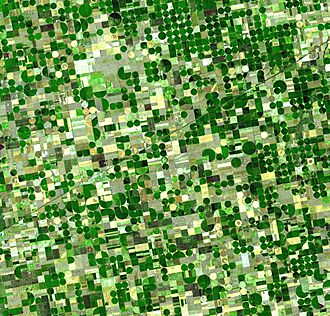
Agriculture faces growing demand for freshwater and unusual rainfall patterns (droughts, floods). It uses 70% of the world's freshwater resources. Water scarcity is increasing, and farming needs to produce more food with less water. Incorrect irrigation can also harm the environment by destroying wetlands and causing land degradation.
Pesticides

Pesticide use has increased a lot since 1950. The World Health Organization estimated in 1992 that three million people are poisoned by pesticides each year, causing 220,000 deaths. Pests can also develop resistance to pesticides, meaning new ones constantly need to be developed.
Some argue that using pesticides and intensive farming is necessary to feed the world and protect nature by growing more food on less land. However, others say that good farming practices, like crop rotation, can reduce the need for pesticides.
Contribution to Climate Change
Agriculture contributes to climate change through greenhouse gas emissions and by converting natural areas like forests into farmland. The agriculture and land use sector contributes between 13% and 21% of global greenhouse gas emissions. Emissions of nitrous oxide and methane make up over half of these. Raising animals is a major source of greenhouse gas emissions.
About 57% of global greenhouse gas emissions from food production come from animal-based foods, while plant-based foods contribute 29%.
Sustainability
Current farming methods use too much water, cause a lot of soil erosion, and reduce soil health. We need to rethink how we use water, land, and ecosystems to grow more food. One solution is to value ecosystems and balance the needs of different users.
New technologies can help farmers make farming more sustainable. For example, conservation tillage is a farming process that helps prevent land loss from erosion, reduces water pollution, and helps store carbon in the soil. Agricultural automation can also help farming adapt to climate change by making resource use more efficient.
Other sustainable practices include conservation agriculture, agroforestry (mixing trees and crops), and improved grazing methods.
Energy Use in Farming
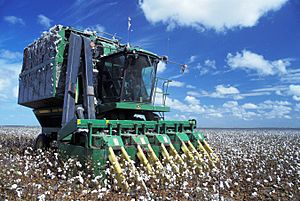
Since the 1940s, farming has become much more productive, largely because of increased use of energy-intensive machines, fertilizers, and pesticides. Most of this energy comes from fossil fuels. The Green Revolution in the 1960s and 1980s greatly increased grain production worldwide. Because farming relies so much on oil and gas, there are concerns that oil shortages could increase costs and reduce food output.
Farms use fossil fuels in two main ways: directly (for tractors and machinery) and indirectly (for making fertilizers, pesticides, and farm equipment). Making nitrogen fertilizer alone can use over half of a farm's energy.
Plastic Pollution
Plastic products are widely used in farming to increase crop yields and use water and chemicals more efficiently. These "agriplastic" products include films for greenhouses, mulch to cover soil, shade cloth, and irrigation pipes.
It's hard to know exactly how much plastic is used in agriculture. A 2012 study reported almost 6.5 million tonnes per year globally. A later study estimated it was between 7.3 and 9 million tonnes in 2015. The widespread use of plastic mulch and the lack of good ways to collect and manage it have led to a lot of plastic waste. These plastics break down into small pieces and build up in the soil.
Agricultural plastics are often hard to recycle because they are very dirty with pesticides, fertilizers, and soil. So, they are often buried, left in fields, or burned. These ways of getting rid of plastic can harm the soil and lead to tiny plastic pieces (microplastics) getting into the environment, including the ocean.
Areas of Study in Agriculture
Agricultural Economics

Agricultural economics studies how agricultural goods and services are produced, distributed, and used. This field combines farming with business and marketing ideas. Major trends in agriculture have always affected economies, from ancient farming systems to modern global trade.
Government policies, like taxes, subsidies (money given to farmers), and tariffs (taxes on imported goods), can greatly change the economic market for farm products. These policies can affect farmers in both developing and developed countries.
Agricultural Science
Agricultural science is a wide field that uses biology, economics, and social sciences to understand and improve farming. It covers topics like how to grow crops (agronomy), plant breeding, plant diseases, soil science, insect studies, and how to manage waste and environmental effects.
The scientific study of agriculture began in the 18th century. In America, funding for "agricultural science" started in 1887 to help farmers with things like fertilizers.
Agricultural Policy
Agricultural policy is the set of decisions and actions governments take about farming at home and importing farm products from other countries. Governments usually create these policies to achieve specific goals, like managing risks (from climate change or natural disasters), ensuring economic stability, protecting natural resources, supporting research, and making sure domestic products can be sold easily. Policies can also focus on food quality and food security (making sure there's enough food for everyone).
Many groups influence agricultural policy, including consumers, large farming businesses (agribusiness), trade groups, environmental groups, and labor unions. The Food and Agriculture Organization of the United Nations (FAO) works internationally to fight hunger and helps create global farming rules.
See Also
 In Spanish: Agricultura para niños
In Spanish: Agricultura para niños
- Aeroponics
- Agricultural aircraft
- Agricultural engineering
- Agricultural finance
- Agricultural machinery
- Agricultural robot
- Agroecology
- Agribusiness
- Agrominerals
- Building-integrated agriculture
- Contract farming
- Corporate farming
- Crofting
- Ecoagriculture
- Farmworker
- Food loss and waste
- Food security
- Hill farming
- List of documentary films about agriculture
- Pharming (genetics)
- Remote sensing
- Rural Development
- Soil biodiversity
- Subsistence economy
- Sustainable agriculture
- Urban agriculture
- Vertical farming
- Vegetable farming



